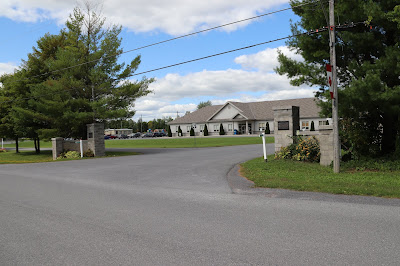In the southwest corner of Major's Hill park to the right of
Lieutenant-Colonel John By's statue stands a structure commemorating the Rideau Canal.
QUITE A CANAL
Below the Parliament Buildings is the entrance to the historic Rideau Canal. Originally constructed as a military supply route, the Rideau Canal now lies at the recreational heart of Canada's Capital and is enjoyed as a national treasure by all.
 |
Rideau Canal Skateway
La patinoire du canal Rideau
NCC / CCN |
TOUT UN CANAL
Le canal Rideau, qui est une réalisation historique, débute au pied de la colline du Parlement. Il aait, à l'origine, une vocation militaire. Aujourd'hui, il est au centre des activités récréatives de la capitale du Canada et est considéré par tous comme un trésor national.
 |
Rideau Canal Locks, before 1841
Écluses du canal Rideau, avant 1841
LAC / 1992-556-1 / BAC |
In 1826, Lieutenant-Colonel John By was sent by the British government to build a canal from the Ottawa River to Lake Ontario. Despite harsh working conditions, Colonel By and his workforce completed this daunting assignment in just six years. The finished product – a navigable waterway carved out of over 200 km of bush, swamp and rock – was truly a remarkable feat of engineering.
En 1826, le gouvernement britannique confia lieutenant-colonel John By la construction d'un canal entre la rivière des Outaouais et le lac Ontario. Malrgé des conditions de travail particulièrement ardues, il fallut mois de six années au colonel By et à ses ouvriers pour venir à bout de cette tâche pénible. Le résultat final – un cours d'eau navigable creusé dans plus de 200 km de fourrés, de marais et de roches – ext réellement un chef d'œuvre de l'ingénierie.
 |
Colonel By supervising Canal construction
Le colonel By supervisant la constuction du Canal
NA / PAC C27570 / AN |
The commissariat building, situated on the west band of the canal, is the oldest stone building in Canada's Capital. In Colonel By's era, it served as a storehouse, office and treasury for the British engineers.
L'edifice de l'intendance, qui se trouve à côté des écluses, au pied de la colline du Parlement, est le bâtiment de pierre plus ancien de la capitale du Canada. Au temps du colonel By, il servait à la fois d'entrepôt, de bureau et de trésorerie aux ingénieurs britanniques.
PROMISING BEGINNINGS
As construction of the Rideau Canal progressed, a small town began to flourish in the surrounding wilderness. Colonel By played an important role in defining the layout of the streets and neighbourhoods in this growing community of canal workers. In recognition of his contribution, the settlement was called "Bytown."
 |
| Quincaillerie à Bytown |
DES DÉBUTS PROMETTEURS
Au fil de la progression des travaux de construction du canal Rideau, une agglomération se constituait dand la nature environnante. Le colonel By joua un rôle important dans l'élaboration d'un plan des rues et des quartiers de ce secteur en plein essor, où s'installaient les ouvriers du canal Rideau. C'est en son honneur que l'on baptisa l'agglomération «Bytown».
 |
Wellington Street, c.1853
Rue Wellington, ver 1853
National Archives of Canada (NA)
C-1548
Archives nationales du Canada (AN) |
Colonel By's layout for some of Bytown's streets has been altered very little over the years and is still recognizable today.
 |
York Street, c.1920
Rue York, vers 1920
NA / C-6254 / AN |
On peut encore voir aujourd'hui le tracé de certaines rues de Bytown effectué par le colonel By, car peu de modifications y ont été apportées.
 |
Ottawa, c. 1859
Ottawa, vers 1859
National Library of Canada
Bibliothèque nationale du Canada |
Sonemasons, engineers and other canal workers came from as far away as Scotland, England and Ireland and decided to settle in the region. By 1855, Bytown had become a city and had adopted a new name: Ottawa. With its wide boulevards and thriving lumber industry, Ottawa was quickly becoming the industrial and commercial centre that Colonel By had so carefully planned for.
Des tailleurs de pierre, des ingénieurs et d'autres ouvriers du canal Rideau, qui venaient d'aussi loin que l'Écosse, l'Angleterre et l'Irlande, décidèrent de s'installer dans la région. En 1855, Bytown, devenue une vrai ville, adopta un nouveau nom: Ottawa. Ottawa se charactérisait alors par de larges boulevards et une industrie du bois florissante. La ville devint rapidement le centre industriel et commercial que le colonel By avait pris tant de soins à concevoir.
 |
Ottawa, Capital of Canada, c.1859
Ottawa, capitale du Canada, vers 1859
NA / C-2813 / AN |
Despite its simple beginnings as a rough construction camp, Ottawa was selected, in 1857, to become the capital of a maturing Canada. Colonel John By is remembered today not only for his impressive Rideau Canal, but also for the founding of Bytown, Canada's future national capital.
Malgré ses humbles débuts comme chanteir de construction, Ottawa fut choisie, en 1857, pour devenir la capitale d'un Canada en pleine évolution. Si l'on se souvient aujourd'hui du colonel By, c'est à la fois pour la réalisation impressionnante du canal Rideau et pour la fondation de Bytown, la future capitale du Canada.






















































